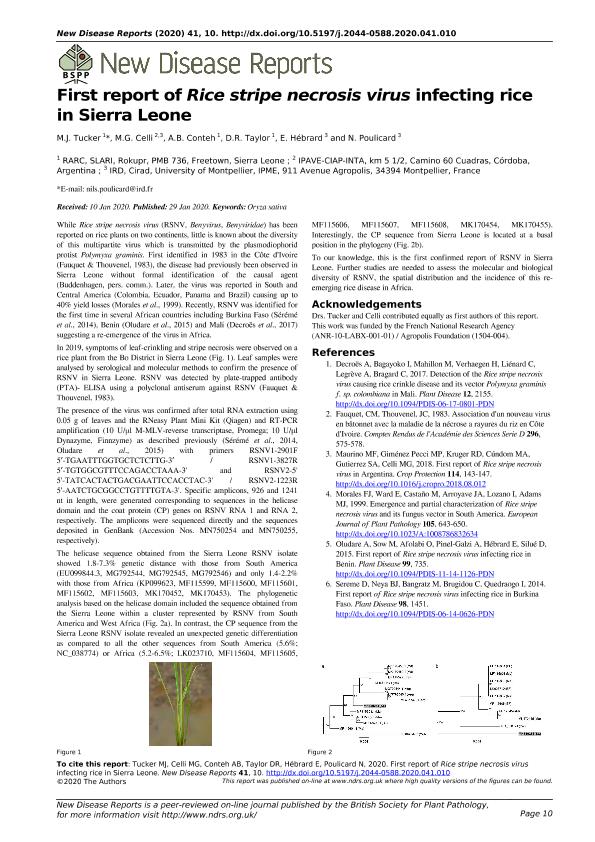Mostrar el registro sencillo del ítem
dc.contributor.author
Tucker, M. J.
dc.contributor.author
Giovani Celli, Marcos Giovani

dc.contributor.author
Conteh, A. B.
dc.contributor.author
Taylor, D. R.
dc.contributor.author
Hebrard, Andrés

dc.contributor.author
Poulicard, N.
dc.date.available
2021-07-01T22:40:04Z
dc.date.issued
2020-01
dc.identifier.citation
Tucker, M. J.; Giovani Celli, Marcos Giovani; Conteh, A. B.; Taylor, D. R.; Hebrard, Andrés; et al.; First report of Rice stripe necrosis virus infecting rice in Sierra Leone; John Wiley and Sons Inc; New Disease Reports; 41; 1; 1-2020; 10-10
dc.identifier.issn
2044-0588
dc.identifier.uri
http://hdl.handle.net/11336/135333
dc.description.abstract
While Rice stripe necrosis virus (RSNV, Benyvirus, Benyviridae) has been reported on rice plants on two continents, little is known about the diversity of this multipartite virus which is transmitted by the plasmodiophorid protist Polymyxa graminis. First identified in 1983 in the Côte d´Ivoire (Fauquet & Thouvenel, 1983), the disease had previously been observed in Sierra Leone without formal identification of the causal agent (Buddenhagen, pers. comm.). Later, the virus was reported in South and Central America (Colombia, Ecuador, Panama and Brazil) causing up to 40% yield losses (Morales et al., 1999). Recently, RSNV was identified for the first time in several African countries including Burkina Faso (Sérémé et al., 2014), Benin (Oludare et al., 2015) and Mali (Decroës et al., 2017) suggesting a re-emergence of the virus in Africa.In 2019, symptoms of leaf-crinkling and stripe necrosis were observed on a rice plant from the Bo District in Sierra Leone (Fig. 1). Leaf samples were analysed by serological and molecular methods to confirm the presence of RSNV in Sierra Leone. RSNV was detected by plate-trapped antibody (PTA)- ELISA using a polyclonal antiserum against RSNV (Fauquet & Thouvenel, 1983).The presence of the virus was confirmed after total RNA extraction using 0.05 g of leaves and the RNeasy Plant Mini Kit (Qiagen) and RT-PCR amplification (10 U/μl M-MLV-reverse transcriptase, Promega; 10 U/μl Dynazyme, Finnzyme) as described previously (Sérémé et al., 2014, Oludare et al., 2015) with primers RSNV1-2901F 5′-TGAATTTGGTGCTCTCTTG-3′ / RSNV1-3827R 5′-TGTGGCGTTTCCAGACCTAAA-3´ and RSNV2-5´ 5´-TATCACTACTGACGAATTCCACCTAC-3´ / RSNV2-1223R 5´-AATCTGCGGCCTGTTTTGTA-3´. Specific amplicons, 926 and 1241 nt in length, were generated corresponding to sequences in the helicase domain and the coat protein (CP) genes on RSNV RNA 1 and RNA 2, respectively. The amplicons were sequenced directly and the sequences deposited in GenBank (Accession Nos. MN750254 and MN750255, respectively).The helicase sequence obtained from the Sierra Leone RSNV isolate showed 1.8-7.3% genetic distance with those from South America (EU099844.3, MG792544, MG792545, MG792546) and only 1.4-2.2% with those from Africa (KP099623, MF115599, MF115600, MF115601, MF115602, MF115603, MK170452, MK170453). The phylogenetic analysis based on the helicase domain included the sequence obtained from the Sierra Leone within a cluster represented by RSNV from South America and West Africa (Fig. 2a). In contrast, the CP sequence from the Sierra Leone RSNV isolate revealed an unexpected genetic differentiation as compared to all the other sequences from South America (5.6%; NC_038774) or Africa (5.2-6.5%; LK023710, MF115604, MF115605, MF115606, MF115607, MF115608, MK170454, MK170455). Interestingly, the CP sequence from Sierra Leone is located at a basal position in the phylogeny (Fig. 2b).To our knowledge, this is the first confirmed report of RSNV in Sierra Leone. Further studies are needed to assess the molecular and biological diversity of RSNV, the spatial distribution and the incidence of this re-emerging rice disease in Africa.
dc.format
application/pdf
dc.language.iso
eng
dc.publisher
John Wiley and Sons Inc
dc.rights
info:eu-repo/semantics/openAccess
dc.rights.uri
https://creativecommons.org/licenses/by-nc-sa/2.5/ar/
dc.subject
BENYVIRUS
dc.subject
ARROZ
dc.subject
RSNV
dc.subject.classification
Agricultura

dc.subject.classification
Agricultura, Silvicultura y Pesca

dc.subject.classification
CIENCIAS AGRÍCOLAS

dc.title
First report of Rice stripe necrosis virus infecting rice in Sierra Leone
dc.type
info:eu-repo/semantics/article
dc.type
info:ar-repo/semantics/artículo
dc.type
info:eu-repo/semantics/publishedVersion
dc.date.updated
2021-05-11T18:11:37Z
dc.journal.volume
41
dc.journal.number
1
dc.journal.pagination
10-10
dc.journal.pais
Reino Unido

dc.journal.ciudad
Londres
dc.description.fil
Fil: Tucker, M. J.. Sierra Leone Agricultural Research Institute; Sierra Leona
dc.description.fil
Fil: Giovani Celli, Marcos Giovani. Instituto Nacional de Tecnología Agropecuaria. Centro de Investigaciones Agropecuarias. Unidad de Fitopatología y Modelización Agrícola - Consejo Nacional de Investigaciones Científicas y Técnicas. Centro Científico Tecnológico Conicet - Córdoba. Unidad de Fitopatología y Modelización Agrícola; Argentina
dc.description.fil
Fil: Conteh, A. B.. Sierra Leone Agricultural Research Institute; Sierra Leona
dc.description.fil
Fil: Taylor, D. R.. Sierra Leone Agricultural Research Institute; Sierra Leona
dc.description.fil
Fil: Hebrard, Andrés. Centre National de la Recherche Scientifique. Institut de Recherche pour le Développement; Francia
dc.description.fil
Fil: Poulicard, N.. Centre National de la Recherche Scientifique. Institut de Recherche pour le Développement; Francia
dc.journal.title
New Disease Reports
dc.relation.alternativeid
info:eu-repo/semantics/altIdentifier/doi/http://dx.doi.org/10.5197/j.2044-0588.2020.041.010
dc.relation.alternativeid
info:eu-repo/semantics/altIdentifier/url/https://bsppjournals.onlinelibrary.wiley.com/doi/10.5197/j.2044-0588.2020.041.010
Archivos asociados
